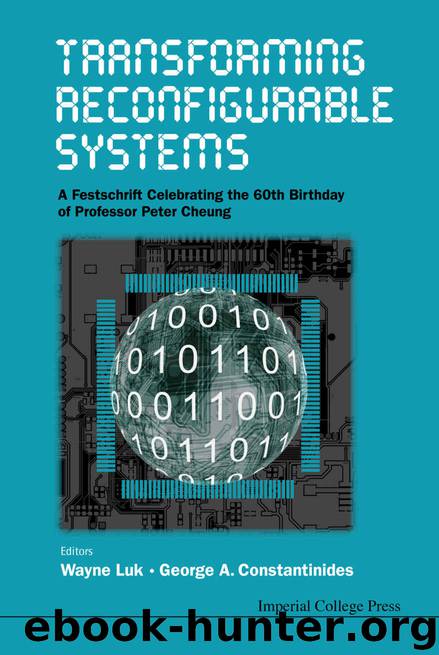Transforming Reconfigurable Systems by Luk Wayne & Constantinides George A

Author:Luk Wayne & Constantinides George A
Language: eng
Format: epub
ISBN: 9781783266982
Publisher: Imperial College Press
Published: 2015-02-25T16:00:00+00:00
Fig. 7.7. An implementation of the Nengo digit-recognition model on a DE4 FPGA board with touch-screen.
7.5. Conclusion
We have demonstrated that a quad-core BlueVec (NIOS II + vector) machine has performance that falls within a factor of two of the custom pipeline for our neural computation case study, and has similar logic usage. The Bluespec code for BlueVec together with vectorised C code proved to be much more compact and easy to develop than the custom pipeline despite using a high-level language (Bluespec).
Vector processing also allows the memory bottleneck to be managed through efficient use of burst access to DDR2/DDR3 memory. Given that the memory bandwidth can easily become the bottleneck, inefficiency in the compute vector compute structures on FPGA becomes mostly irrelevant. Perhaps it is not too surprising that a vector multiprocessor can achieve excellent performance on FPGA given that GPUs (which are also vector multiprocessors) are highly competitive [Ref. 17]. FPGAs do, however, offer the flexibility to tailor the vector unit to the application, e.g. using custom arithmetic operations. But perhaps more importantly for massively parallel systems, FPGAs offer the ability to customise the inter-chip communication network to suit the application.
Download
This site does not store any files on its server. We only index and link to content provided by other sites. Please contact the content providers to delete copyright contents if any and email us, we'll remove relevant links or contents immediately.
| Automotive | Engineering |
| Transportation |
Whiskies Galore by Ian Buxton(41935)
Introduction to Aircraft Design (Cambridge Aerospace Series) by John P. Fielding(33085)
Small Unmanned Fixed-wing Aircraft Design by Andrew J. Keane Andras Sobester James P. Scanlan & András Sóbester & James P. Scanlan(32763)
Craft Beer for the Homebrewer by Michael Agnew(18194)
Turbulence by E. J. Noyes(7977)
The Complete Stick Figure Physics Tutorials by Allen Sarah(7334)
Kaplan MCAT General Chemistry Review by Kaplan(6897)
The Thirst by Nesbo Jo(6877)
Bad Blood by John Carreyrou(6581)
Modelling of Convective Heat and Mass Transfer in Rotating Flows by Igor V. Shevchuk(6406)
Learning SQL by Alan Beaulieu(6235)
Weapons of Math Destruction by Cathy O'Neil(6206)
Man-made Catastrophes and Risk Information Concealment by Dmitry Chernov & Didier Sornette(5951)
Digital Minimalism by Cal Newport;(5699)
Life 3.0: Being Human in the Age of Artificial Intelligence by Tegmark Max(5506)
iGen by Jean M. Twenge(5384)
Secrets of Antigravity Propulsion: Tesla, UFOs, and Classified Aerospace Technology by Ph.D. Paul A. Laviolette(5330)
Design of Trajectory Optimization Approach for Space Maneuver Vehicle Skip Entry Problems by Runqi Chai & Al Savvaris & Antonios Tsourdos & Senchun Chai(5036)
Pale Blue Dot by Carl Sagan(4949)
